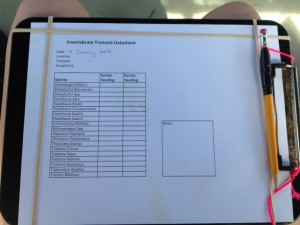Hello all! Quick culture note: Belau is Palauan for Palau! Today was our last Conservation and Development class and we got to spend it monitoring Ngederrak, a Koror state marine protected area (MPA). The MPA was established in 2001 as a no entry zone, therefore activities such as fishing and diving were prohibited within Ngederrak. In 2003, it was opened for a period of about two weeks and a derby commenced–fishing boats were out in full force, reaping the benefits from the protection that the MPA afforded to the marine species living there. After this brief interlude, Ngederrak was closed again–this time permanently.
The permanent closure gave people like Paul Collins, an independent marine researcher, a chance to monitor the changes that occur in an MPA over time. Paul has lived in Palau for the past few years and he has spent much of his time here studying Ngederrak. When meeting with him, we learned that he mainly relies on both high resolution satellite imagery and field surveys to assess how the MPA can help protect marine species and habitats.
We were to assist with surveys initiated by David Ginsburg of the University of Southern California, who brings a class of students every year in May to monitor biodiversity in Ngederrak. By surveying in January, our class could provide data to help assess seasonal changes in biodiversity (so now Duke University can be considered a collaborator for the Ngederrak monitoring initiative!). Our group was on the look out for invertebrates, which included sea cucumbers, clams, sea urchins, and trochus shells. We hopped onto a Koror state boat, with the same wonderful ranger crew who took us to the Rock Islands, ready to go with our snorkeling gear.


After a quick refresher on how to get our bearing using a compass, we conducted our first set of transect surveys. The initial set was the toughest because the strong current made it extremely difficult to keep the transect line straight. The subsequent surveys were much easier as they were done in areas where current was much weaker. My group of four only saw three invertebrates along all of our transects, but another group saw more than 60 clams when they were surveying one site! A number of our surveys were conducted in dense seagrass beds and I know many of us were hoping to see an elusive dugong during our monitoring activities. There was one false alarm, which turned out to be a school of fish swimming at the surface of the water. Unfortunately, there were no dugongs spotted.
Our work wrapped up around 1:30 PM and the data we collected will be compiled and sent to David so that it can be incorporated into his research. My hope is that Paul and David’s work can be used to further inform the management of Ngederrak. Oftentimes, MPAs are established and then that’s that–which is not good news for the viability and effectiveness of MPAs. In many cases, there is very little time and resources dedicated to monitor what goes on within an MPA after protection is granted. It is great to see that this is not the case for Ngederrak! Especially when monitoring these areas once they are afforded protection can be very useful in terms of adaptive management of MPAs. I wonder if and how Ngederrak’s management plan may change once research results are available to policy makers at Koror State.
I am glad that our class was able to help with the monitoring of Ngederrak. The Palauans that we have meet throughout our time here have been so welcoming and extremely generous with their time. It wouldn’t feel right to leave without contributing to Palau in some way. I am sure I speak for all of my classmates when I say our trip to Palau was a wonderful experience. Hopefully, some of us will be able to return in the future. Goodbye Belau (for now)!
